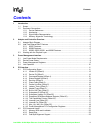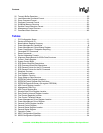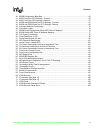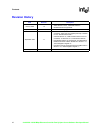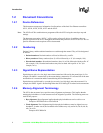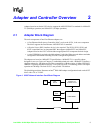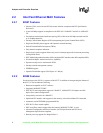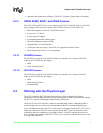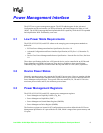
2 Intel 8255x 10/100 Mbps Ethernet Controller Family Open Source Software Developer Manual
Introduction
1.2 Document Conventions
1.2.1 Device References
This document encompasses information for all members of the Intel Fast Ethernet controllers:
82551, 82550, 82559, 82558, 82557 and the 82562.
Note: The 82562xx/ICHx combination are programmed like the 82559 using the same byte map and
settings.
The document convention, “8255x,” will be used to refer to all devices. In addition, there are
specific references to the 82557 throughout this manual that pertains to all 8255x devices. Device-
specific differences and exceptions will be documented.
1.2.2 Numbering
Decimal, binary, and hexadecimal numbers are used through the manual. They will be designated
as follows:
• Decimal numbers: Decimal numbers will not be followed by a suffix.
• Binary numbers: Binary numbers (base 2) will be followed by a “b” (for example, 01b).
• Hexadecimal numbers: Hexadecimal numbers (base 16) will be followed with the suffix “h”
(for example, 1Ch). Hexadecimal numbers may also be noted with a prefix of “0x” (for
example, 0x1c).
1.2.3 Signal Name Representation
Signals that are active in a low logic state when asserted are followed by the pound sign (#). For
example, FRAME# is asserted low by the master during a transaction. It is asserted low at the start
and duration of a transaction and de-asserted during the final data phase.
Signals that are not followed by a pound sign are active in a high logic state when asserted. For
example, the IDSEL signal is asserted high when the 82559 during PCI read and write transactions.
1.2.4 Memory Alignment Terminology
The 8255x data structures have special memory alignment requirements. This implies that the
starting physical address of a data structure must be aligned as specified. The following terms are
used for this purpose:
• Byte alignment: Byte alignment implies that the physical addresses can be odd or even.
Examples: 0FECBD9A1h or 02345ADC6h
• Word alignment: Word alignment implies that physical addresses must be aligned on even
boundaries. In other words, the last nibble of the address may only end in 0h, 2h, 4h, 6h, 8h,
Ah, Ch, or Eh.
Example: 0FECBD9A2h




